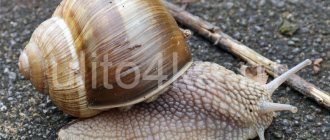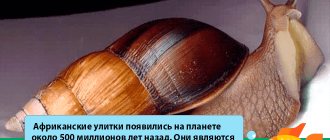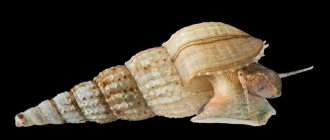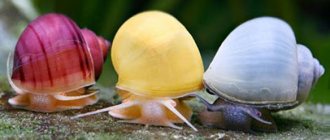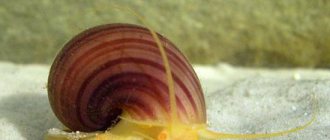There is probably not a single gardener who is not familiar with the snail. For some it is a malicious pest, for others it is a delicacy. The history of the grape snail in Belarus goes back several centuries. According to one version, it was brought from Italy by Radziwill Sirotka as a fashionable snack. In the time of the Radziwills, snails were called “smauzhy”, which were also an exotic decoration - an element of park culture. Monks also grew snails in cabbage beds.
These gastropods also attracted the attention of Pavel Stanislavchik from the Nesvizh region. True, he relied not on the grape snail, but on the small gray snail helix aspersa muller, creating the Snails Bel Garden snail farm. He admits that several years ago he didn’t even think about any gastropods: he was running his own construction business. In order to establish concrete production, he bought an empty school building in the village with an adjacent 1 hectare of territory. But the project did not meet sanitary standards: after all, there are residential buildings nearby. Then I turned my thoughts to mushrooms, but ended up focusing on snails. I read that snail farming is a business for the lazy, but that was not the case. The matter turned out to be troublesome and began to take up all my free time.
My wife Irina (a teacher by training) supported her husband’s idea. I must say that they met on the snail theme. On one of our trips we visited a snail farm in Poland. We got excited about the idea: at that time, no one had ever raised such small cattle in Belarus.
Since then, the Stanislavchikov family has laid out all tourist routes exclusively taking into account those places where one could see how these gastropods are bred: Italy, Spain, Ukraine, Portugal...
In 2019, Pavel Viktorovich was one of the first to be included in the Register of Enterprises of the Eurasian Economic Union as an official snail producer with the right to export it. So, last year, from an area of 700 sq. m collected 1600 kg of shellfish. Although more could have been done. But due to objective global reasons, the farmer is not yet increasing the pace. And this business is very profitable: profitability is more than 100%.
Pavel admits that at first it was not easy: there were too many questions, the answers to which fellow snail breeders were in no hurry to give. The technology of growing a snail is a complex process where the temperature and humidity of the earth, the amount and composition of feed, the time of awakening of the mollusks, ventilation, lighting and much more are very important. But thanks to painstaking work, their own experiments and observations, the Stanislavchikov family can now teach those who want to start growing Mediterranean snails in the Belarusian climate.
The uniqueness of this snail is that its meat is white and very tender. Gourmets put it first in terms of taste. And the whole thing is eaten, and not just the “leg”, like that of a grape snail. The average weight of an adult is 6-10 g. Its mollusk fattens in 5-6 months. Just like an annual garden crop.
And in appearance, the snail farm is somewhat similar to a large bed, fenced around the perimeter with a special mesh. Panel houses are installed throughout the territory. The fact is that these gastropods are nocturnal. When darkness falls, they come out to feed. The hot daytime sun is dangerous for them. They are comfortable at a temperature of plus 20-25 degrees Celsius. If it is below plus 12 or above plus 30, the snails hibernate. Which, of course, significantly lengthens their growth period.
And in order for gastropods to actively increase protein (no, not fat), they are also specially watered in the evening. Humidity should be at least 90-95%. Then the snails do not sleep, eat better and grow very quickly.
For this purpose, a watering system was installed above the plantation, similar to the one installed in cutting greenhouses. And the net is stretched, but this is already protection from birds. The birds will not fail to feast on the tender fry.
The mesh is also laid along the bottom. The result was a kind of border no more than half a meter high. Don’t think that snails are such idiots - by the way, they could easily overcome this obstacle if it weren’t for the electric shepherd laid in two rows with a power of 9-12 volts. Such a fence reliably protects against escapes.
It must be said that the menu of these gastropods is exclusively ecological. Refusing purchased feed, Pavel himself prepares a mixture of wheat, barley and corn, finely grinding the grain. Instead of premixes, he adds vegetables to the mixture - cucumbers, pumpkin, zucchini, carrots, cabbage, apples... Calcium is also required on the menu: the shell must be strong. Chalk is scattered across the field and mixed into the feed.
Grass is sown in March. And in May, as soon as the temperature at night is set at no lower than plus 5 degrees, he releases the snails into an area where a hybrid of rapeseed and Chinese cabbage is already green. Until September they are here and graze, growing to the required size. Their maturity can be determined by the edge of the sole. When it becomes hard, the snail will no longer grow.
In the fall, before the cold weather, Pavel and Irina collect the entire snail, using scoops similar to those used to collect blueberries. Only cut from five-liter plastic bottles. The largest mollusks are deposited separately. This is the future broodstock. They (as well as others) are stored in the refrigerator at a temperature of plus 2-8 degrees. In such an environment, the snails go into suspended animation, tightly covering the shell with a film to maintain a comfortable microclimate inside. And they can sleep like this for up to a year.
Just before spring, when it’s time to repopulate the plantation. In May, the couple releases the broodstock onto the plantation. The snail mates, laying cocoons, each containing more than 100 young.
Housing for your pet and proper care
A street snail can live in an ordinary aquarium, left over from a fish hobby that has not taken root. If you don't have an aquarium, you can use a terrarium or a large plastic container. Soil is poured onto the bottom; enough of it is needed so that the snail can burrow into it, since it serves as a bed for them. The substrate must be wet, but no water should come out when compressed.
Interesting! The soil in the terrarium plays an important role; during breeding, they make nests in it; the softer it is, the easier it is for them to make a place for laying eggs.
In addition, wild garden and forest snails are considered climbers; they often climb walls, and if they fall, the ground protects them from injury. But sawdust cannot be used, as they can eat it.
Read more about what to use as a terrarium and how to equip it for snails
When using store-bought coconut substrate for street snails, it is pre-soaked in water for several hours. When using land, it is taken from a park or forest. It is important that there are no fertilizers or chemicals in it. Before laying the house, it should be calcined at high temperatures or boiled. You can use ready-made soil for begonias from flower shops.
Instead of purchased soil, you can use sphagnum moss or peat, only neutralized. If the peat has high acidity, the forest snail shell will begin to deteriorate quickly.
Read about other types of soil for snails.
A lid is placed on the container. You can’t live without it, since the snail taken from the street is wild and very inquisitive, especially at home. She can run away and get lost. If it falls, it will break the sink or eat the wallpaper on the walls, which is also not allowed.
You can buy a terrarium, soil and other equipment for caring for forest and street snails on Aliexpress.
Mode
Grape snails are active only at night. During the day they sleep, hiding in their house, and at night they eat and walk. When you approach the terrarium in the morning, you can find a dug up substrate, food remains, and mucous stains on the walls.
In addition to daytime sleep, long-term suspended animation is very important for snails. In nature, it begins with a strong increase in air temperature, the onset of cold weather or drought. At home, such conditions will have to be created artificially to stimulate the onset of hibernation. Otherwise, the mollusks will begin to wither and get sick, their lifespan will be shortened, and growing and maintaining them will become problematic.
Experienced shellfish breeders use 2 approaches:
- Temporal. The change in activity and suspended animation of creatures takes place according to a clearly defined schedule. For example, a pet stays awake for three weeks and falls into a long sleep for a week.
- Natural. The terrarium simulates the same conditions as outside. During rainy periods we increase the humidity, on dry days we create dryness, and when it gets cold we lower the temperature.
You can choose any of the two approaches and follow it all the time.
What to feed wild animals at home?
In the first days of their lives, small street snails eat the shell of their eggs, which contains all the necessary substances. However, as adults, individuals change their gastronomic tastes. For example, grape snails love to eat young grape leaves, which is why they got their name. At home, the owner can feed the pet more varied.
Favorite foods also include leaves:
- Strawberries;
- Raspberries;
- Dandelion;
- Plantain.
Sometimes they can be found on horseradish, radish, cabbage and some other types of crops. Animals mainly feed on rotten parts, but it can also damage a healthy plant. Adult forest snails also feed on juicy fruits, so they readily eat fruits and berries, in particular strawberries in the spring.
Despite the fact that gastropods are considered herbivores, it has been noted that they can also eat food of animal origin - broken eggs, insect larvae, worms.
At home, forest and garden snails are omnivorous, but it is important that the food is fresh and juicy.
Forbidden! Dangerous products!
- Salt and chemical fertilizers;
- Bitter, sour, ready-made food for other domestic animals;
- Bread, pasta;
- Beans in any form and raw potatoes.
All other vegetables and fruits are allowed. Separately, you can cook chicken, boiled potatoes and eggs for wild garden snails, the main thing is not to add salt.
Most often, street pets are fed what they eat in the wild. But at home, protein and calcium are added to their diet.
Protein is found in specialized supplements such as daphnia and gammarus, and at home you can prepare simple and tasty snail food.
You should know it! It is not advisable to give snails pork or other meat; for them it is very tough and difficult to digest.
Wild snails need plenty of calcium. In nature, what street snails eat is already rich in calcium, but it should always be given at home. For this purpose, special sepia is used, from the store or feed chalk. You cannot use school chalk, it contains a lot of chemicals.
Important! It is strictly prohibited to use tablets from a pharmacy as calcium, as it is poison for them.
The mineral content is high in shell rock, chicken egg shells and fish bone meal. But all this must be ground in a coffee grinder in advance.
At home, wild street snails are fed once a day, preferably in the evening, as they sleep during the day. But over time, their rhythm may change.
Laying eggs
Mollusks begin to lay offspring no earlier than 20–30 days after mating. They first prepare the nest by digging a suitable sized hole in the ground. Having carefully compacted the walls and bottom, the parent lays 30 to 40 eggs in the hole. Outwardly, they look like pearls - just as round, white and shiny. Having finished throwing offspring, the snail fills the hole with the eggs with soil.
The babies hatch from the soft shell and begin to dig their way out. After 9–11 days, they are safely released, feeding on the remains of their own shells and soil along the way.
Young snails, when fed abundantly, increase in size in record time. After 30 days they become 4 times larger than at birth. You can feed them the same as adults. The growing process is no different from keeping mature mollusks.
Garden snails at home
Garden snails are not only sold in stores; in most parts of the country they can simply be brought from the garden. Grape snails may also be found among them. Caring for snails is easy; you should create conditions for them similar to wild ones.
Arrangement of a house for a garden snail
For pets to live, they need a terrarium with a size of about 19 liters and a wide bottom, as well as equipped with a lid with holes for ventilation. If the lid is missing, the mollusk can escape, since they easily climb along a vertical plane.
It is necessary to organize proper ventilation. There should be plenty of holes, since the street snail breathes oxygen and emits carbon dioxide.
The optimal temperature is room temperature, which must be maintained the same at all times.
Snails need soil at the bottom of the house; it is better to purchase ready-made soil in the store, it is absolutely safe and does not contain harmful bacteria. If this is not possible, then you can collect soil from the garden and process it at high temperatures for at least 30 minutes.
A natural substance can be laid on top of the soil; for this, sphagnum moss, peat or compost are used. Such a natural layer will maintain the required level of moisture in the soil.
For maximum activity, it is recommended to decorate the house. To do this, you can use artificial logs or tunnels from a pet store or real ones from the garden. Then the garden snail will be able to climb on them and hide if necessary.
Amazing decor for the terrarium can be purchased on the website.
Mollusks need moisture; for this, all objects and soil are regularly sprayed from a bottle. This procedure is carried out every two days.
It is advisable to spray the pets themselves, this will increase their health and beauty.
You need to feed the snail every day, but you should find out what forest and garden snails eat at home. They are unpretentious in nutrition. They enjoy eating fresh vegetables and fruits, herbs and cereals. Salting food is strictly prohibited. All products are finely chopped, making them easier for pets to eat.
Walking
Snails do not need to go for walks like other pets, but fresh air has a very good effect on them - the gastropods' appetite improves and their activity increases. They are taken outside on a cold day in a container. A very short walk is enough for them - only about half an hour. At this time, it is necessary to carefully ensure that the snail’s skin does not dry out; for this, it is recommended to spray it with water from time to time. Keep container away from direct sunlight.
There is no need to let your pets on the grass - sushi snails can attract predators and also catch parasites. These are very fragile creatures that are difficult to treat because it is very difficult to find a veterinarian for such a pet. In any case, you do not need to risk your health and life.
Diversity of land snails
The most famous land mollusks include ordinary snails or, as they are also called, garden snails.
They differ from marine and pulmonary ones by the presence of a breathing hole. Basically, all snails of this type are herbivores, but some eat insects. You can have them as pets. Some species can live for 20 years.
Grape snail
The grape snail lives on average 8 years, but maybe longer. This shellfish is eaten and considered a delicacy. It stays awake from spring until the first autumn frosts. Then it goes into hibernation. An adult can reach 5 centimeters. Feeds on plants. You can meet snails in Central and Eastern Europe. The grape snail is easy to distinguish from other common street mollusks.
Today there are farms in the world where they are grown for food. And in nature you can find it in parks, on bushes, trees, vineyards, and in the grass.
Common Yantarka
Yantarka affected by the parasite
Common Yantarka has a transparent shell. It lives in many European countries and even North America. Snails are found in damp places and can sometimes submerge in water. They live only from 13 to 17 months.
Chains
Cepei is a genus of large snails. The height of snail shells reaches 16mm, and the width is 20mm. The length of the flail body reaches 40mm. Due to deforestation and the collection of snail shells by collectors, chains are included in the list of specially protected objects. The head and legs of some species may be translucent.
Austrian chain
The Austrian chain is a fairly common species. You can meet it in Russia, Hungary, Lithuania, Poland, Czech Republic, Bulgaria, Austria, Moldova and Ukraine. The chain has a cube-shaped shell with five whorls. Color - from white to yellow, with dark brown stripes. Eggs are laid at the end of July in moist soil. Lives on average 3 years.
Woody variant
The woody variantha has a spherical shell with smoothed curls. The shell color varies from yellow to brown.
A special feature of the species are small spots and streaks. The tree variant is found in Western and Central Europe, mainly in the mountains and relatively humid areas.
Shiny snail
The shiny snail is a steppe species; it chooses dry meadows, bushes, and forest edges for its habitat. Found in Slovakia, Hungary, Romania, Poland, Ukraine and Belarus. It has a spherical shell with four whorls, white or yellowish in color.
Bush snail
The bush snail has a round, large shell ranging in color from gray to red-brown and even blue-black. It can be found in Western Asia, as well as in Eastern and Central Europe. Prefers wet fields and meadows, or forest edges. It feeds on grass plants and goes into hibernation from October. It reproduces, like many mollusks, by laying eggs in the ground.
Faustina faustina
Faustina faustina is widespread in the Carpathians, but it can also be found on the plains; it is actively found in the Vinnytsia region. It chooses forested areas for its habitat. It is considered one of the most beautiful snails due to its shiny conical shell.
Cepaea sylvatica
Cepaea sylvatica is one of the rarest species of chains. Can be found in Northern and Central Europe. In Russia, this chain can be found in the Leningrad and Kaliningrad regions. Prefers well-warmed areas. It feeds on lichen, detritus and some types of fungi. It reproduces by laying eggs in the ground.
Gibbula divaricata
Gibbula divaricata lives off the coast of the Black, Adriatic and Mediterranean seas. In the Black Sea, gibbula can be found along the entire coast. The mollusk is easy to identify by its cone-shaped shell with seven or six whorls. Feeds on detritus and algae.
The mollusk reproduces in the summer, throwing eggs into the sea.
Bielzia coerulans
A very unusual and rare representative of the mollusks Bielzia coerulans, also called Limacida. It has an amazingly beautiful color (purple, blue or green). You can meet it in Ukraine, the Czech Republic, Poland, Slovakia and Romania, in coniferous and mixed forests. It belongs to the pulmonary group and does not have a shell. The body length of bielsia is from 10 to 14 centimeters. It is a hermaphrodite, and after laying eggs the snail dies.
Description
The grape snail has an elastic, movable body and a hard, static shell.
The diameter of the latter is from 3.5 to 5 cm. This is quite enough for the body to completely fit in the spirally twisted “house”. The color of the shell is heterogeneous, consisting of light and dark stripes. Color varies from chestnut-white to yellowish-olive. The surface of the shell is ribbed.
The body of the grape snail, like that of other mollusks, is very elastic and can change size from 3 to 10 cm. It is painted beige or gray with a brown tint. The surface of the body is rough, wrinkled, designed to retain moisture.
The color of the body can change depending on the food consumed by the mollusk.
There are 4 movable tentacles on the head that play the role of sensory organs. The front ones perform a tactile function, the rear ones perform a visual function.

